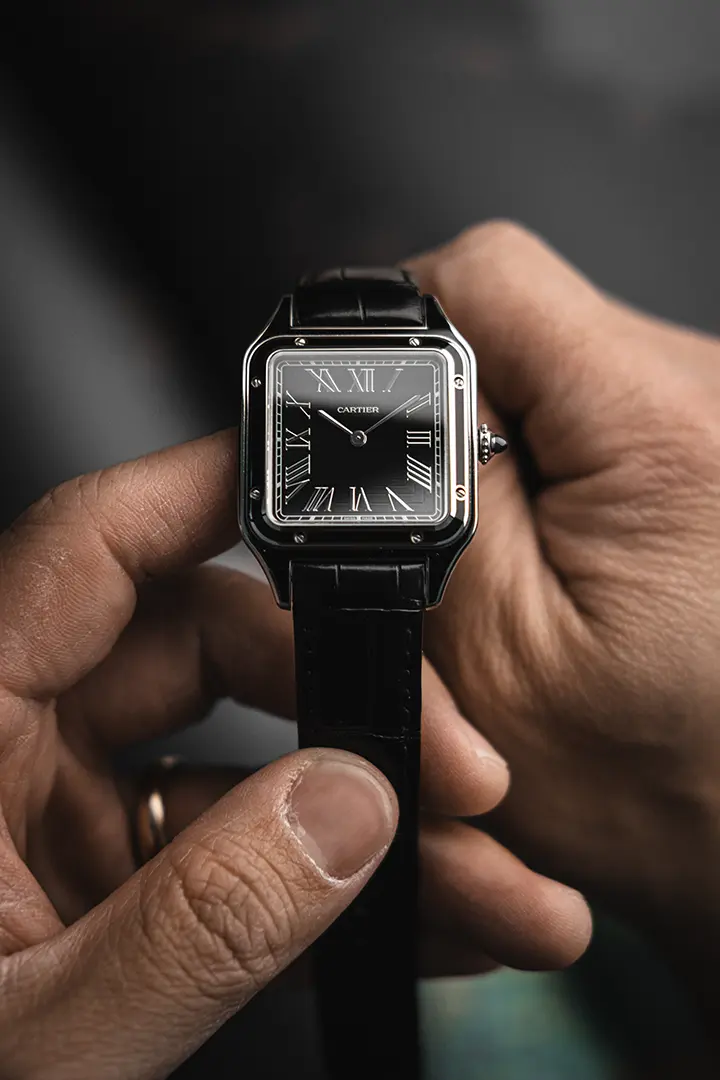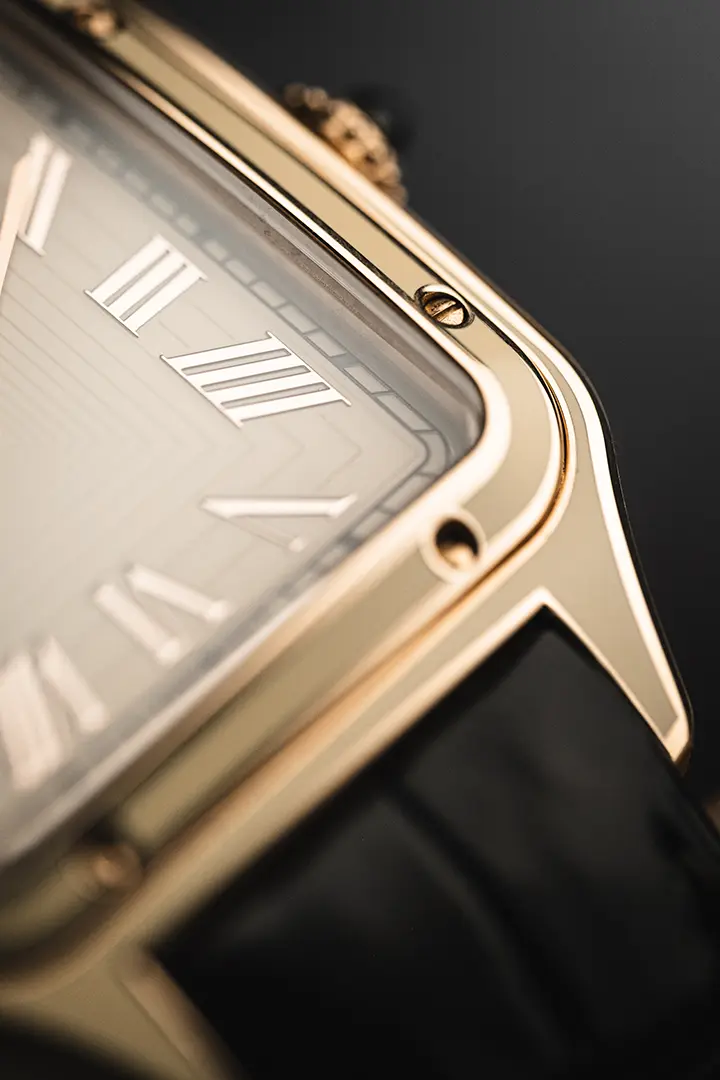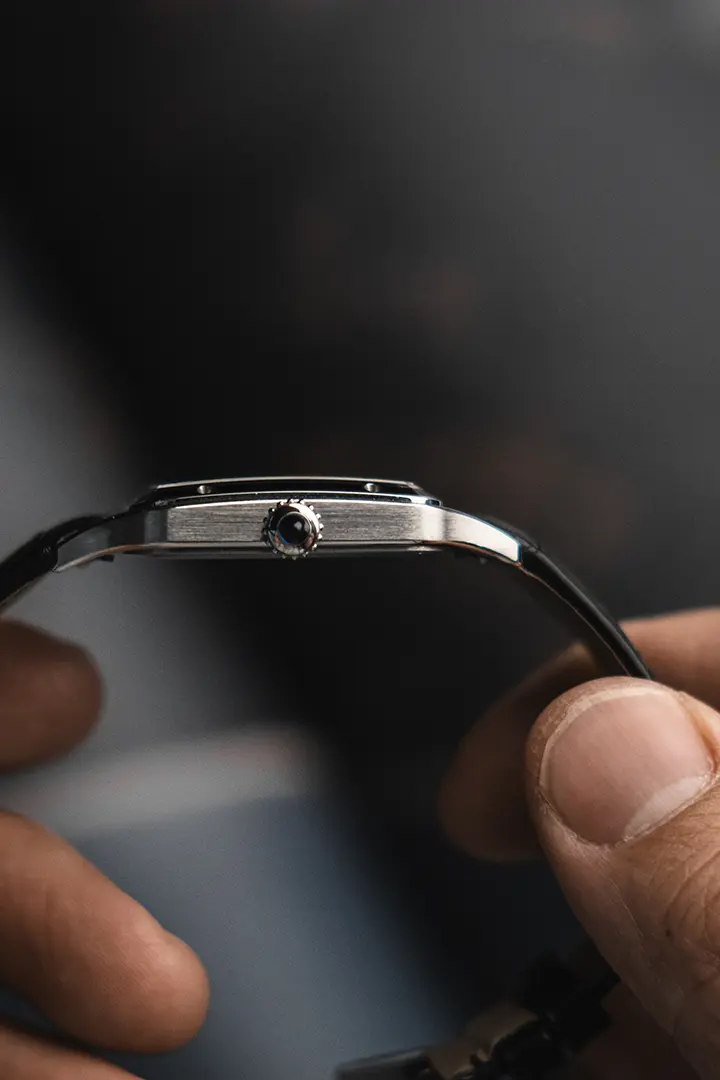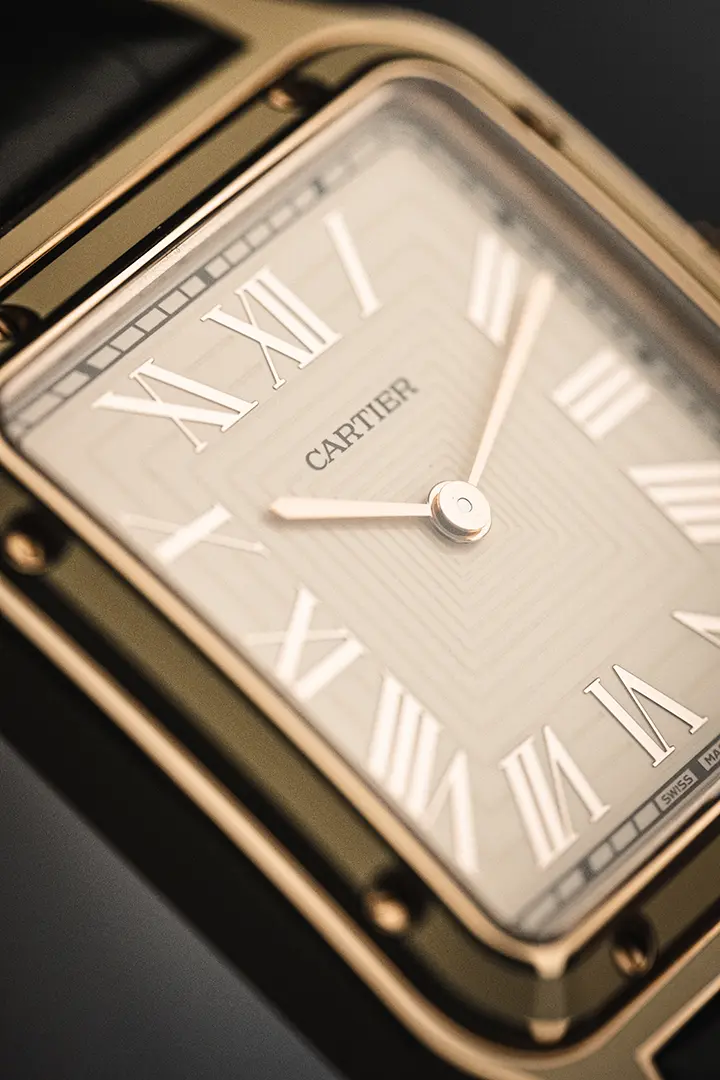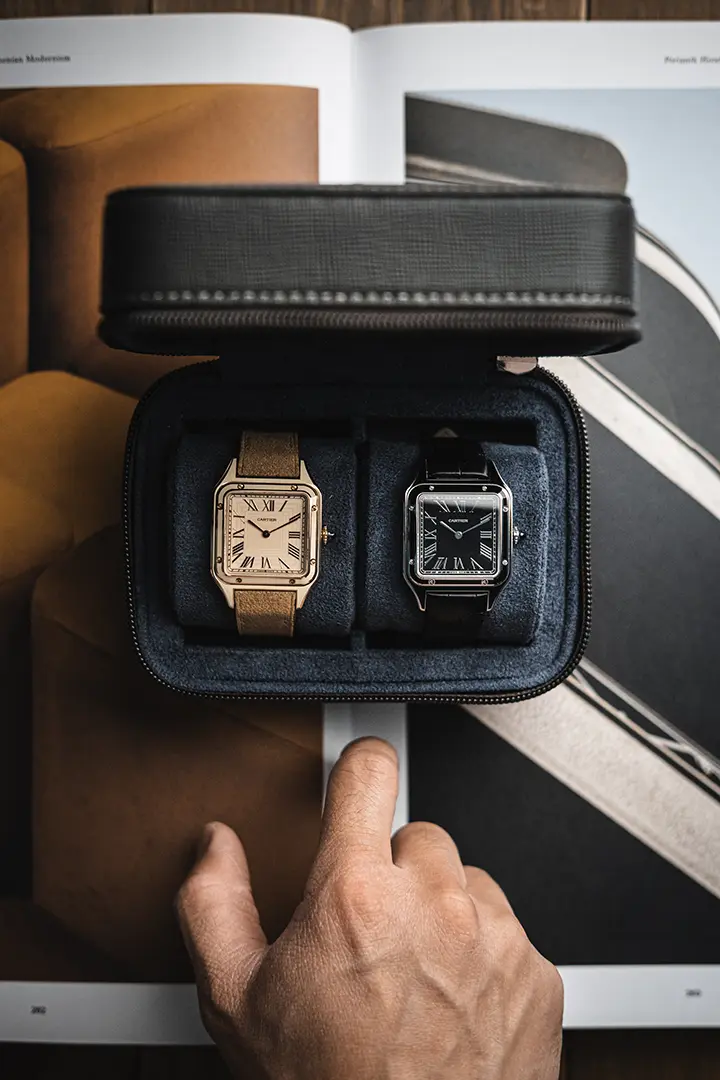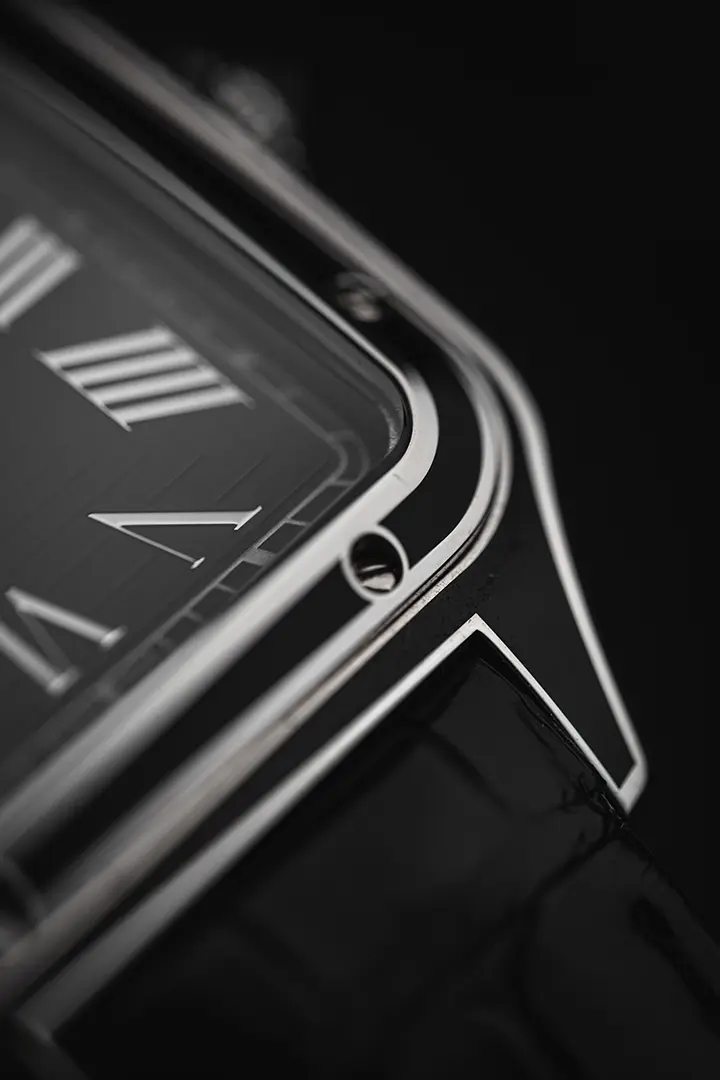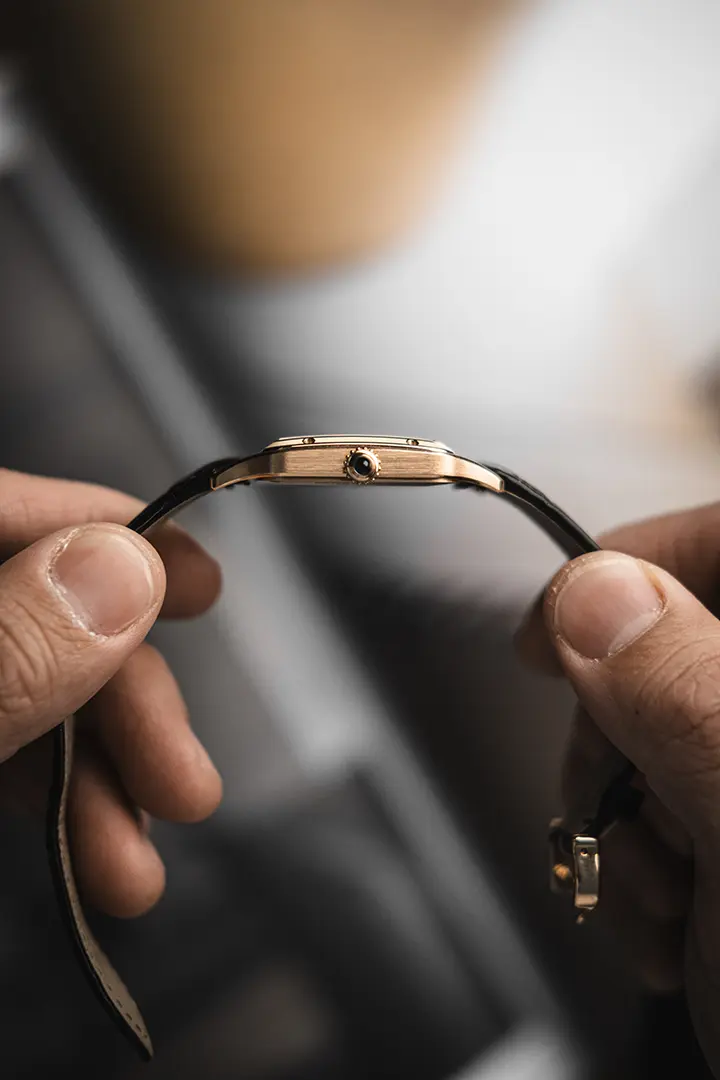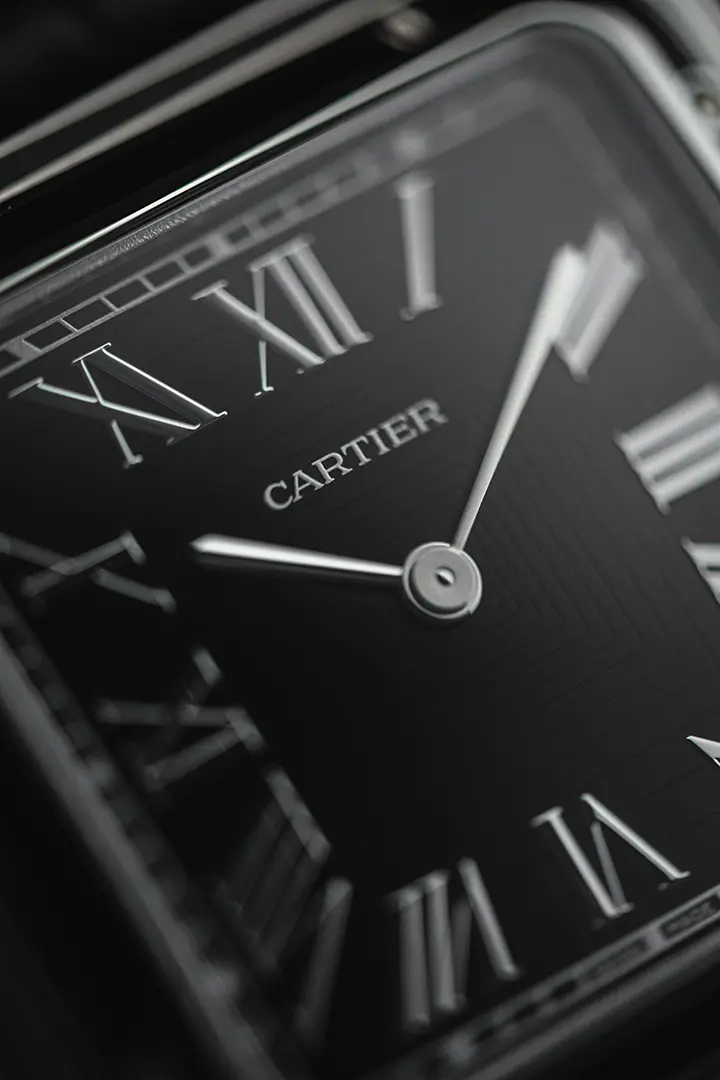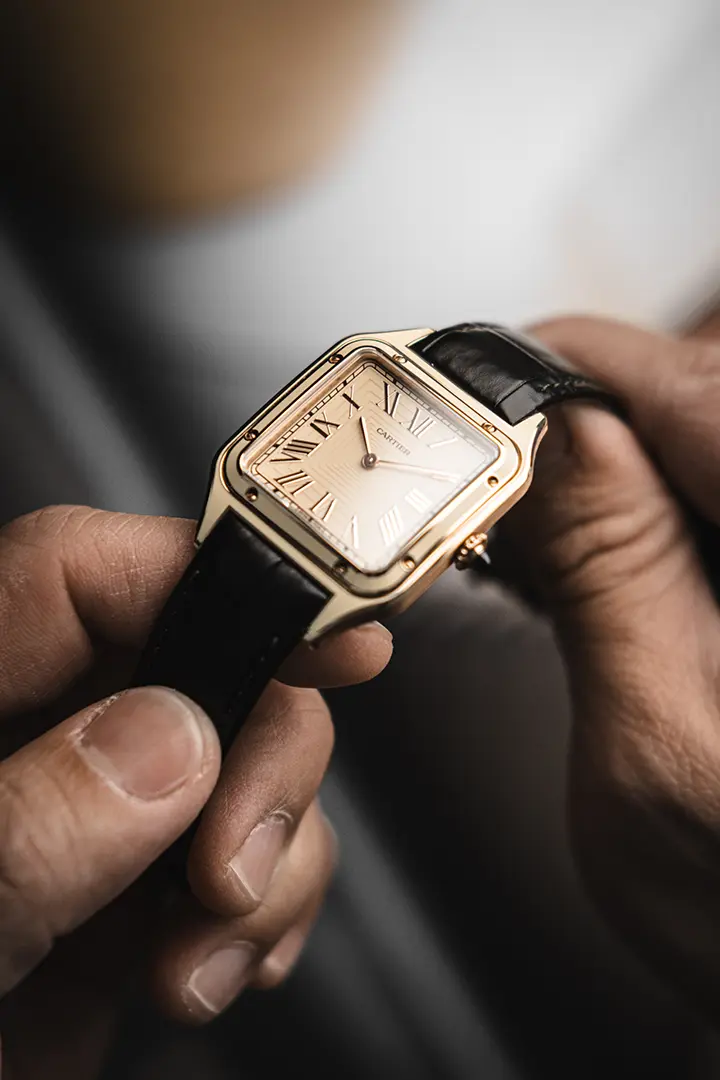Cartier 2022 Santos-Dumont Lacquer, Steel WSSA0046 and Rose Gold CRWGSA0054
“It’s simply one of my favourite and most interesting timepieces in my collection.”
I initially overlooked Cartier as a watch brand, viewing it more as a “design” house than a true watchmaker. So, it was surprising to learn about the Santos-Dumont this far into my journey – the first men’s, tool and aviation wristwatch in history. Born from friendship and a spirit of invention, the Santos-Dumont has a storied history.
In its spirit of collaboration, I’m pleased to bring Verne Ho into the conversation. A connoisseur of Cartier watches and a talented photographer (@watchstudies), Verne not only shares his insights but also captures the watch through his lens – all photos of the lacquer Santo-Dumonts are his.
Specifications
- Model: 2022 Santos-Dumont Large
- Retail Price: $4,400 USD / $10,300 USD (in 2022)
- Reference: WSSA0046 or WSSA0068, CRWGSA0054
- Movement: Manual-Winding Caliber 430 MC, non-hacking, 18 jewels, 21,600 vph
- Power Reserve: 38 hours
- Dial: Engraved Lacquer Dial in Black / Cream
- Bezel: Lacquer embossed, Steel / Rose Gold
- Case: 43.5 mm x 31.4, 43.5mm lug-to-lug, decorated case back, with studded crown capped with a blue/red cabochon
- Thickness: 7.3mm
- Water Resistance: 30m
- Crystal: Domed signed plexiglass
- Lug Width: 17mm
- Strap: Alligator in Matte Black or Black Calfskin / Dark Green with Cartier Signed Buckle (steel / 18k rose gold)
- Produced: 2022 onwards
Acquired: Jan. 9, 2024, in trade with The 1916 Company.
.
Why I Got It
Like many watch enthusiasts, my journey began with sports watches. After adding a vintage dress watch I believed my collection was complete. However, in a business office environment, I often felt the need to lean dressy without being overly formal. My vintage dress watch, though elegant, felt at odds with modern, darker business wear. I needed something understated yet refined – a dark dial for evenings, slim enough to slide under a cuff, but with a restrained presence. Enter the steel black lacquer Santos-Dumont WSSA0046.
Verne “I was immediately drawn to the new line of lacquered Santos-Dumonts as a modern, fun, and tasteful re-interpretation of one of Cartier’s most iconic timepieces. While my heart was initially set on steel and black lacquered reference for its versatility and elegance, my wife and SA rightfully nudged me in the direction of the rose gold and vanilla-lacquered reference instead. The subtlety of the vanilla lacquer against the warmth of the rose gold case has to be one of the most dynamic tonal pairings I have ever come across on a timepiece. Every turn under a light offers something a little different. It’s simply one of my favourite and most interesting timepieces in my collection. And I nearly missed out on it.”
Not ‘Why I Got It,’ but something I came to understand – the Cartier Santos-Dumont embodies a pivotal chapter in horological history. So much so that I’ve included a heritage passage, which still just skims the surface of its fascinating story.
.
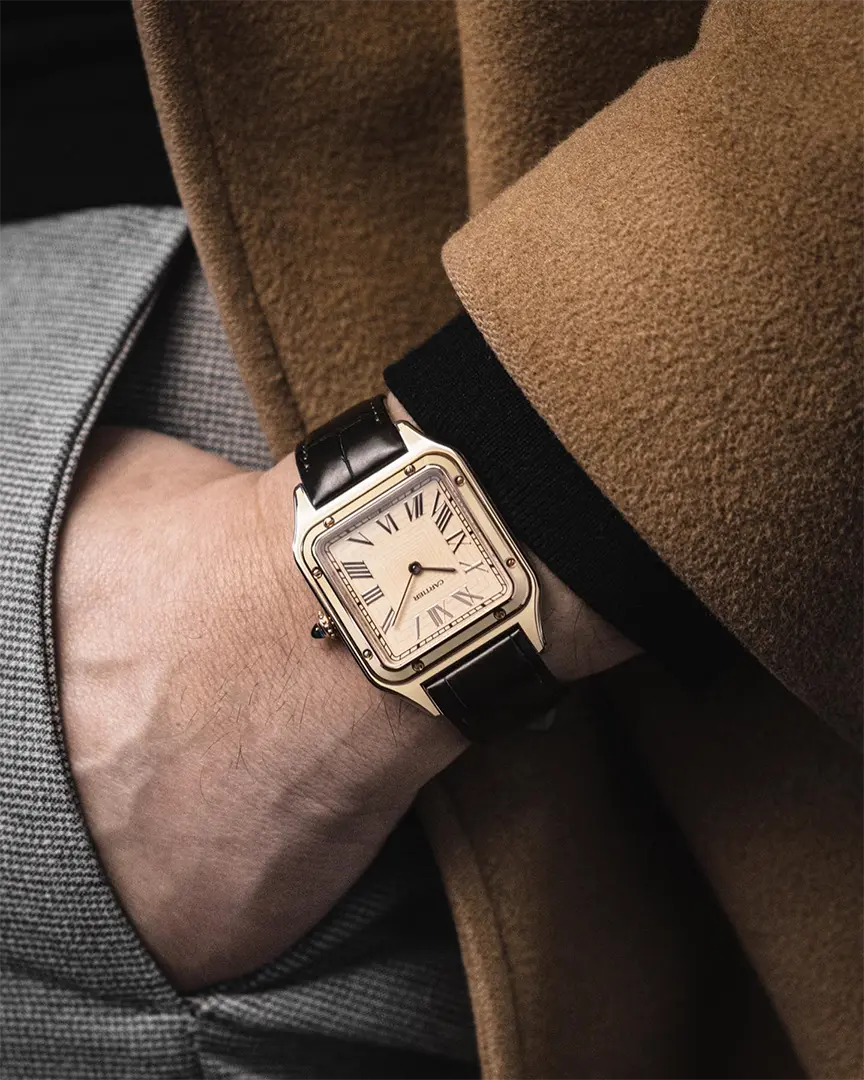
How it Wears
On the wrist, the two Santos-Dumonts offer distinct experiences and are more versatile than one would expect.
The steel with black feels modern and this is due to the lacquer enhancing the lines and shapes. During the day, it’s the textural dial’s engraved square patterns that catch the eye. Under evening lights, it’s all about the case-lines with the applied lacquer highlighting its sharp contours.
On the other hand, the gold lacquer edition offers a contrast that is more subtle; hard to explain or capture, but demonstrated in the adjacent photos. Equally changing throughout day and night, but keeping to a classic aesthetic with an understated contemporary twist. Similarly, the gold is just as versatile as the steel, but has a wearing experience where the gold inlay blends in more with the case and dial.
“It’s far from being like anything else I’ve ever owned. It is both indulgent and refined while leveraging the classic design language that brings me even closer to the history that had me head over heels for the Santos to begin with. By every definition, it is a special occasion watch but surely one that I’ll make excuses to wear every day.” Vern
It took a while to notice, but skin undertone subtly influences how each model wears—steel suits cooler and neutral tones, while rose gold leans warmer. That said, personal style, clothing, and taste easily override any such ‘rule’.
.
Despite the “large” designation, the watches (43.5 mm x 31.4 with lug-to-lug at 43.5mm) wears smaller than its dimensions suggest. Furthermore, the darker colour makes the steel version feel slightly smaller than the beige. However, Cartier watches hold the distinction of being able to break wrist size rules and fits equally well on both small (5.75”) and large wrists (any size really).
The Cartier alligator straps are stiff, and that’s by design; they take some time to work into your wrist, but are very comfortable after that. The colours are thoughtfully coordinated; steel with glossy black and gold with dark green.
.
How it Wears – Casual
Classic fitting T-shirts and jeans work with both references. With the steel, the contrast created by the alligator straps added a formal tension.
“The gold unintuitively dresses down when paired with a rubber strap, which nobody in their right mind would ever think to do. If you’re up to having your perspective changed though, try it with Delugs rubber cut-to-size straps and you’ll unlock a whole new set of personalities.” Verne
The exposed screws (reminiscent of aircraft construction and the steel beams of the Eiffel Tower) anchors the look with a confident, industrial edge.
Finally, the gently curved case and thoughtfully smooth caseback engravings reflect Cartier’s commitment to comfort. The watch wears effortlessly, even after a full day.
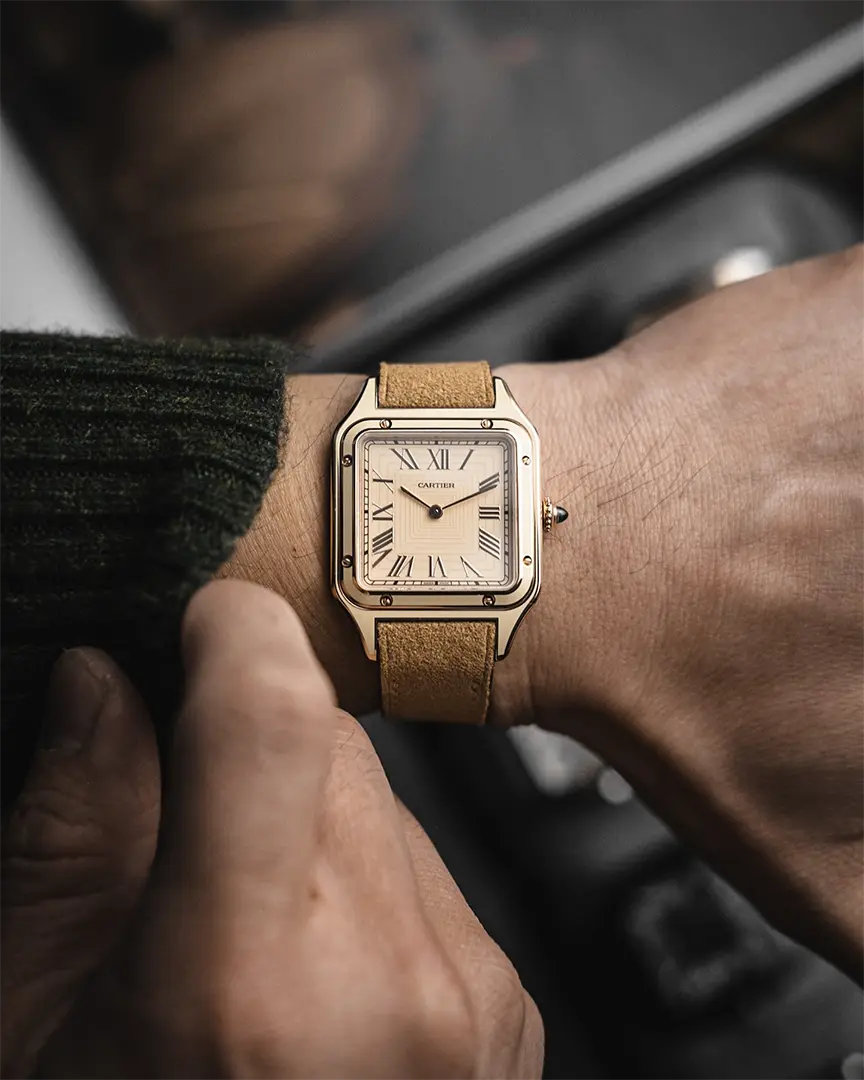
.
Heritage
When I acquire a vintage watch, I love to learn about how it connects to the past, its historical context or significance and the people before me who might have worn it. There’s always interesting stories. But learning about the Cartier Santos-Dumont left me awestruck – yet also disappointed. Awestruck that this was the first confluence of the purpose-made gentleman’s tool, square and aviation wristwatch, whose initial design became unmistakably Cartier. Disappointed, with so few in-depth historical studies available.
The early 20th century was an era of bold innovation. Cities glowed with electric lights, automobiles replaced horse-drawn carriages, and aviation – once the stuff of science fiction – became reality. If the 19th century was an era of discovery, the 20th was one of invention and industrialization, defined by groundbreaking advancements, cultural revolutions, and shifting geopolitics. At the heart of this exhilarating new age, Cartier introduced the Santos-Dumont – the first wristwatch purpose-built for a pioneer of modern flight.
1901 - Race Against Time
Alberto Santos-Dumont, an aeronaut, sportsman and inventor, challenged the Coupe Deutsch de la Meurthe, a 30-minute 22.6-kilometer air race flying from Paris’s Parc de Saint-Cloud to the Eiffel Tower and back.
“... thousands of people turned out to watch him circle the Eiffel Tower in his innovative airship. The crowds on the bridges over the Seine were so thick that people were shoved into the river when they scaled the parapets to get a better view. (Hoffman 2)”
Human flight was still in its infancy, and Santo-Dumont's demonstration of the potential of controlled, powered flight ignited public imagination.
1904 - Birth of the Modern Wristwatch
During a dinner conversation, Santos-Dumont expressed to his friend Louis Cartier the difficulty of checking his pocket watch while piloting. Though he had won the race, Santos found it impossible to check his time. “His hands were so busy with the numerous cords and controls that he could not pause to take out his pocket watch. (Hoffman 217)”.
Inspired, Cartier designed a wristwatch tailored for aviators, featuring integrated lugs, a leather strap, a square case, exposed bezel screws and cabochon-set crown.
This innovative timepiece, born out of necessity and friendship, marked the inception of the modern wristwatch.
1906 - Aviation Heritage
Santos-Dumont made history with the first publicly witnessed powered heavier-than-air flight aboard the 14-Bis of his own making.
Known as much for his daring exploits as his stylish flair, Santos-Dumont “was a fixture in the Paris skies” (Hoffman 3) and captured the imagination of the world. In his personal one-man airship, he could be seen flying down the Paris boulevards and tying his Baladeuse (Wanderer) to the gas-lamp posts in front of the city's many glamorous night spots (Brickel 60).
Widely considered the world’s first aviator wristwatch, Santos’s exploits helped popularize both aviation and wristwatches.
1911 - Transforming Horology and Fashion
Officially released and aptly named the “Cartier Santos”, it was produced in collaboration with Edmond Jaeger (see Jaeger-LeCoultre), who provided the hand-wound movement. Though the “watch on wrist” came in 1571 (as a bracelet worn by Queen Elizabeth) and later (jury-rigging pocket watches or wristlets) in the military (1880s, 1850s), it was not a societal norm.
“... men across Paris modelled their hats and clothes after his, even copying the red ties he sports in the air. He was that legendary figure” (Wings of Madness 0:23:50)
Worn by one of the most “interesting men” of the era, the Santos-Dumont became a functional and fashionable must-have for the gentleman and adventurer.
1978 - Daring Steel and Gold
Cartier relaunched the Santos-Dumont, rebranding it as the “Santos de Cartier” with a bold design that featured steel and gold, integrated bracelet, quartz movement and introduced a raised bezel with visible screws. The “now” signature design elements echoed the industrial age and paid homage to Cartier's Paris roots and aviation heritage.
Among the first two-toned luxury sports watches with an integrated bracelet, it reflected a cultural shift toward pragmatism and prestige
Cartier set a new stage for modern affordable luxury while moving past the last vestiges of the quartz crisis.
The Cartier Santos-Dumont is a watch that carries the weight of a rich legacy, born from a friendship between two pioneering figures – Louis Joseph Cartier, a visionary who adored the art of watchmaking, and Alberto Santos-Dumont, an audacious adventurer whose love for flight pushed the boundaries of possibility. From its inception as the first tool watch designed specifically for aviation to become the first men’s wristwatch and the first to take flight, the Santos-Dumont very much represents the spirit of the 20th century and some of its most defining moments.
Yet, I’d argue the most interesting thing about the Cartier Santos-Dumont is that it set the stage for what wristwatches mean, even today – as a tool, a gift and an expression of identity, ingenuity and craftsmanship.
Under the Loupe
What sets Cartier apart is not just the courage to embrace change, but the rare ability to boldly do so without compromising that underlying je ne sais quoi that defines them. You can own a generational collection of the same Cartier watch without feeling like there’s any overlap. Yet, each reference is still a Santos-Dumont. In this case, even the same models of steel and gold distinctly stand on their own.
“Legend has it, the rose gold and vanilla lacquered design almost didn’t make the cut. Understandably so, compared to the steel and platinum colour pairings, juxtaposing a creamy beige tone against rose gold just doesn’t sound right on paper. But once you see it in the metal, it hits on a whole other level.” Verne
The lacquer dial, protected by a curved sapphire crystal, features concentric squares that subtly add depth to the glossy backdrop. From a distance, the steel dial appears solid black, but up close, its intricate pattern catches the light, revealing depth and texture.
“In gold, the cream is more subdued, but similarly is a study of revealing details over inspection.” The lines creating the concentric squares are engraved; a meticulous hand-finishing process of layering, curing, polishing and specialized machinery.” Verne
Cartier could have stopped at the dial, but their mastery of blending materials, refined in jewelry since the 1920s, took the craftsmanship even further. Lacquered inlays are incorporated into the watch’s distinguished bezel and case. In steel, the chamfers and curves are especially accentuated with the black lacquer finish juxtaposed for contrast.
“On the other hand, the beige lacquer complements, adding sophistication and warmth to the case.” Verne
Speaking about the metals, Cartier’s proprietary rose gold has has been refined with a touch of warmth and resistant to tarnishing.
.
Under the Loupe – Continued
Unlike the quartz movement in the mainline Santos-Dumont, the lacquer models feature the manual-winding Cartier 430MC, a modified Piaget 430P movement. This is a nice touch, as having the manual-winding and mechanical is both historically accurate and appropriate in maintaining the watch’s thin (7.3mm) profile. Cartier executes quartz movements marvelously, but a manual-winding movement is a great choice here, offering a moment in the day to appreciate the watch’s intricacies.
The straps are made from high-quality calfskin or alligator leather with a slim profile and precise fit. The Following Cartier’s high standards, only the finer cuts of leather with premium uniform patterns and textures are selected.
“The straps sit perfectly flush and are easily changed using Cartier’s trademark QuickSwitch.” Verne
Being a Cartier, the Santos-Dumont carries the signature Cartier hallmarks: blue spinel cabochon (a touch of brilliance) atop a beaded crown, square bezel with exposed rivets (a nod to aviation and industrial heritage), and Cartier buckle (soft curves with a mirror finish).
Also honouring its heritage, the engraved caseback displays ‘Cartier’, signature-styled ‘Santos-Dumont’ (inked in the same lacquer) and ‘mécanique’. The rose gold also has a uniquely engraved edition number.
“From its Art Deco influences to its lacquer integration, the watch is a testament to Cartier’s mastery of blending tradition with innovation. Its enduring design, characterized by its square case and exposed screws, has influenced generations and remains unique.” Verne
Every finishing detail reflects Cartier’s refinement – expertise honed over three centuries, and seven design generations – blending precision watchmaking and high jewelry artistry.
.
One Year Later
“One of the reasons why I own multiple Cartier watches, is that each iteration is so excitingly distinct, but somehow maintains the essence of timelessness. I have found that I can wear my Santos-Dumonts on any occasion. In a very different way, these watches are strap monsters, you can go dressy to even casual rubber and somehow it all works.” Verne
I initially saw the Santos-Dumont lacquer as my go-to evening watch perfect for modern business attire. It filled that role flawlessly, but what surprised me was how effortlessly it worked with casual wear. The sleek profile, black lacquer contrasted by the industrial bezel and exposed screws allow it to pair just as effortlessly with a T-shirt and jeans.
But beyond its versatility, it’s an iconic piece not only in design, but in its storied history.
I’ve come to appreciate why Verne and other Collectors might own multiple Cartier Santos-Dumonts. Wearing the Santos-Dumont has deepened my appreciation for Cartier’s designs. So much so that I’ve just added a Tank Must de Cartier WSTA0108 to my collection.
If we had one minor criticism, the lacquered dial is simply spectacular, and a subtle anti-reflective treatment (on the underside of the sapphire) would have enhanced its depth under broader lighting conditions. That said, this is a small trade-off for a watch that has exceeded expectations in every way.
Though they appear delicate, both watches look just as good today as when they were purchased. The brushed finishes conceal minor nicks, and the lacquer remains pristine. The bezels – often criticized in the standard model as scratch magnets – still look great. I don’t handle my watches roughly, but Verne wears his rose gold Santo-Dumont everywhere.
A year later, the Santos-Dumont lacquer remains just as captivating with lots of wrist time, adapting to any occasion with a distinct presence. Few watches can claim such a balance of refinement, versatility, and historical significance. Whether as a one and done, cornerstone or a complement to a collection, the Santos-Dumont in any variation, is a watch worth owning.
.
Where to Buy
Unveiled at Watches & Wonders 2022 in three variations: platinum (150 pieces), rose gold (250 pieces) and steel (slated for regular production). Priced at $4,400 USD (steel) and $10,300 USD (gold). However, the watches were not readily available until 2023.
As of this article (May 2025), finding one in-store, even the steel, is unlikely. I acquired mine trading up, and Verne had the foresight to buy his rose gold in-store at launch. Though “regular production” speculation suggests the steel may be capped at 800 pieces. In hindsight, I wish I had secured mine through cartier.com or an AD reservation instead of hesitating due to wanting to see it in person.
For those still on the hunt, some regions still show the steel at Cartier’s Online Store and perhaps calling in for a transfer might be possible. At the time of this article, I was told there was only one rose gold left in Canada.
With the Cartier quickSwitch consider looking at Delugs who provide compatible Integrated Straps and also a broader variety of options and price points.
.
Works Cited
Brickell, Francesca Cartier. The Cartiers: The Untold Story of the Family Behind the Jewelry Empire. Ballantine Books, 2019.
Hoffman, Paul. Wings of Madness: Alberto Santos-Dumont and the Invention of Flight New York : Hyperion, 2003.
Wings of Madness
Wings of Madness. Directed by Jean-Marc Selva and Brian Dowley, Docere Digital Studios, Inc. and Palace Production Center, 2006.
.

